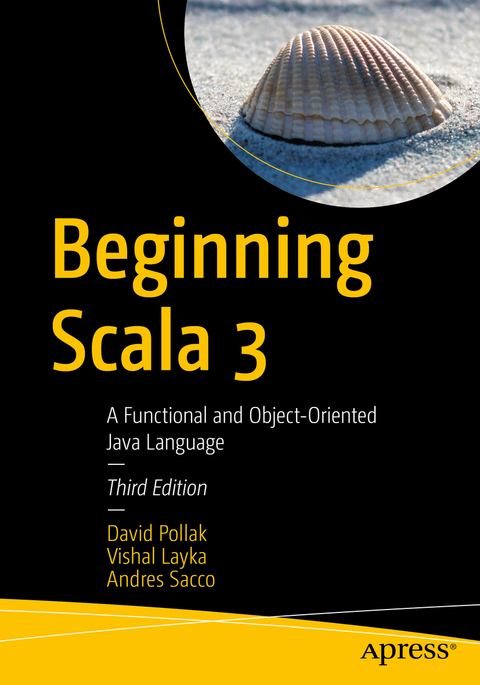
Beginning Scala 3
Apress (Verlag)
978-1-4842-7421-7 (ISBN)
Beginning Scala 3 explores new Scala 3 language features such as Top-level declarations, Creator applications, Extension methods to add extra functionality to existing types, and Enums. You will also learn new ways to manipulate types via Union types, intersection, literal, and opaque type aliases. Additionally, you’ll see how Implicits are replaced by given and using clauses.
After reading this book, you will understand why Scala is judiciously used for critical business applications by leading companies such as Twitter, LinkedIn, Foursquare, the Guardian, Morgan Stanley, Credit Suisse, UBS, and HSBC – and you will be able to use it in your own projects.
What You Will Learn
Get started with Scala 3 or Scala language programming in general
Understand how to utilitze OOP in Scala
Perform functional programming in Scala
Master the use of Scala collections, traits and implicits
Leverage Java and Scala interopability
Employ Scala for DSL programming
Use patterns and best practices in Scala
Who This Book Is For
Those with a background in Java and/or Kotlin who are new to Scala. This book is also for those with some prior Scala experience who want to learn Scala version 3.
David Pollak has been writing commercial software since 1977. He wrote the award-winning Mesa spreadsheet, which in 1992 was the first real-time spreadsheet. Wall Street companies traded billions of dollars a day through Mesa. In 1996, David sold his company to CMP Media and became CTO of CMP Media's NetGuide Live and was one of the first large-scale users of Java and WebLogic to power an Internet site. In 1998, David released Integer, the world's first browser-accessible, multiuser spreadsheet. Since 2000, David has been consulting for companies including Hewlett-Packard, Pretzel Logic/WebGain, BankServ, Twitter, and SAP. David has been using Scala since 2006 and is the lead developer of the Lift Web framework. Vishal Layka is the chief technology officer of Star Protocol. He is involved in the architecture, design, and implementation of distributed business systems, and his focus is on consulting and training with the JVM languages. Hislanguage proficiencies include Java, Groovy, Scala, and Haskell. Vishal is also the lead author of Beginning Groovy, Grails, and Griffon (Apress, 2012). When he needs a break from technology, Vishal reads eclectically from calculus to star formation. Andres Sacco has been a professional developer since 2007, working with a variety of languages, including Java, Scala, PHP, NodeJs, and Kotlin. Most of his background is in Java and the libraries or frameworks associated with it, but since 2016, he has utilized Scala as well, depending on the situation. He is focused on researching new technologies to improve the performance, stability, and quality of the applications he develops.
1. Getting started with Scala.- 2. Basics of Scala.- 3. Object-oriented Modeling.- 4. Functional Programming.- 5. Pattern Matching.- 6. Scala Collections.- 7. Traits and Enums.- 8. Scala Type System.- 9. Scala and Java Interoperability.- 10. DSL and Parser Combinator.- 11. Simple Build Tool.- 12. Creating Web Applications.- 13. Testing Our Code.- 14. Scala Best Practices.
| Erscheinungsdatum | 28.01.2022 |
|---|---|
| Zusatzinfo | 34 Illustrations, black and white; XXII, 321 p. 34 illus. |
| Verlagsort | Berkley |
| Sprache | englisch |
| Maße | 178 x 254 mm |
| Themenwelt | Informatik ► Programmiersprachen / -werkzeuge ► Scala |
| Mathematik / Informatik ► Informatik ► Software Entwicklung | |
| Mathematik / Informatik ► Informatik ► Theorie / Studium | |
| Schlagworte | Beginner • Beginning • Code • dynamic • Functional • introducing • Introduction • Java • Java-based • OOP • Programming language • Scala • Scala 3 • Scripting • Software • source • Tutorial |
| ISBN-10 | 1-4842-7421-0 / 1484274210 |
| ISBN-13 | 978-1-4842-7421-7 / 9781484274217 |
| Zustand | Neuware |
| Informationen gemäß Produktsicherheitsverordnung (GPSR) | |
| Haben Sie eine Frage zum Produkt? |